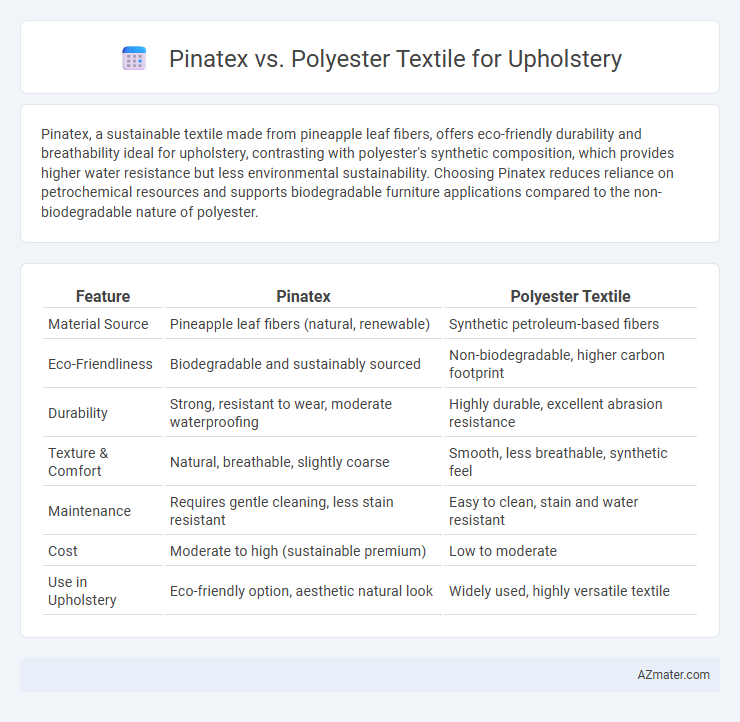Pinatex, a sustainable textile made from pineapple leaf fibers, offers eco-friendly durability and breathability ideal for upholstery, contrasting with polyester's synthetic composition, which provides higher water resistance but less environmental sustainability. Choosing Pinatex reduces reliance on petrochemical resources and supports biodegradable furniture applications compared to the non-biodegradable nature of polyester.
Table of Comparison
| Feature | Pinatex | Polyester Textile |
|---|---|---|
| Material Source | Pineapple leaf fibers (natural, renewable) | Synthetic petroleum-based fibers |
| Eco-Friendliness | Biodegradable and sustainably sourced | Non-biodegradable, higher carbon footprint |
| Durability | Strong, resistant to wear, moderate waterproofing | Highly durable, excellent abrasion resistance |
| Texture & Comfort | Natural, breathable, slightly coarse | Smooth, less breathable, synthetic feel |
| Maintenance | Requires gentle cleaning, less stain resistant | Easy to clean, stain and water resistant |
| Cost | Moderate to high (sustainable premium) | Low to moderate |
| Use in Upholstery | Eco-friendly option, aesthetic natural look | Widely used, highly versatile textile |
Introduction to Piñatex and Polyester Textiles
Pinatex, an innovative sustainable textile made from pineapple leaf fibers, offers an eco-friendly alternative to traditional upholstery materials by reducing agricultural waste and minimizing environmental impact. Polyester, a synthetic fabric derived from petroleum, is widely used in upholstery for its durability, affordability, and resistance to stains and wrinkles. Comparing Pinatex and polyester highlights the growing demand for sustainable textiles versus the practicality and cost-efficiency of synthetic fibers in furniture applications.
Material Origins: Piñatex vs Polyester
Pinatex is an innovative, sustainable textile derived from pineapple leaf fibers, a natural byproduct of agricultural waste, promoting eco-friendly practices and reducing fabric waste. In contrast, polyester is a synthetic fabric produced from petrochemical-based polymers, relying heavily on fossil fuels and contributing to environmental pollution during production and disposal. The biodegradable properties of Pinatex make it a preferred choice for sustainable upholstery compared to the non-biodegradable, microplastic-releasing polyester.
Environmental Impact and Sustainability
Pinatex, a sustainable textile made from pineapple leaf fibers, offers a biodegradable and renewable alternative to polyester, which is derived from non-renewable petrochemicals and contributes significantly to microplastic pollution. The environmental impact of Pinatex includes reduced waste by utilizing agricultural by-products and lower carbon emissions in production, whereas polyester's manufacturing process involves high energy consumption and releases greenhouse gases. Choosing Pinatex for upholstery supports circular economy principles and reduces reliance on fossil fuels, making it a more eco-friendly option for sustainable interior design.
Durability and Longevity
Pinatex, a sustainable alternative made from pineapple leaf fibers, offers strong tensile strength and natural breathability, making it resistant to wear and tear in upholstery applications. Polyester textiles, known for their high durability and resistance to stretching, shrinking, and abrasion, often outperform natural fibers in longevity under heavy use. While polyester can last longer in commercial settings due to its synthetic resilience, Pinatex provides an eco-friendly option with competitive durability suitable for moderate use.
Comfort and Aesthetic Appeal
Pinatex offers a breathable, natural texture with a soft hand feel that enhances comfort in upholstery applications, contrasting with the less porous, synthetic smoothness of polyester textiles. The unique pineapple leaf fibers in Pinatex provide an organic, matte finish that adds warmth and visual interest, while polyester often delivers a uniform, glossy appearance prone to looking artificial. Durability aligns closely, but Pinatex stands out for eco-friendly appeal and tactile richness, making it a preferred choice in sustainable interior design.
Maintenance and Cleaning Requirements
Pinatex, derived from pineapple leaf fibers, requires gentle cleaning with mild soap and water to maintain its texture and prevent fiber damage, making it eco-friendly but moderately delicate for upholstery. Polyester textiles, known for their durability and stain resistance, tolerate more rigorous cleaning methods including machine washing and chemical cleaners, offering ease of maintenance for high-traffic furniture. Choosing between Pinatex and polyester depends on desired sustainability and the frequency and type of upkeep expected for upholstery materials.
Cost Comparison and Affordability
Pinatex, derived from pineapple leaf fibers, presents a sustainable alternative to traditional polyester textiles in upholstery, generally featuring a higher initial cost due to eco-friendly production methods. Polyester, widely produced from petroleum, remains more affordable and readily available, making it a popular choice for budget-conscious consumers seeking durability and stain resistance. Cost comparison reveals Pinatex's price premium is offset by its environmental benefits and growing demand for plant-based materials, while polyester maintains dominance in cost-sensitive markets due to its lower manufacturing expenses.
Applications in Upholstery Design
Pinatex, a sustainable textile made from pineapple leaf fibers, offers eco-friendly upholstery options with a soft, leather-like texture ideal for furniture in residential and commercial spaces. Polyester, a synthetic fabric known for its durability, stain resistance, and color retention, is widely used in high-traffic upholstery settings such as offices and public seating. The choice between Pinatex and polyester depends on design priorities: sustainability and natural aesthetics versus longevity and easy maintenance.
Consumer Preferences and Market Trends
Pinatex, a sustainable leather alternative made from pineapple leaf fibers, is gaining traction among eco-conscious consumers seeking biodegradable and cruelty-free upholstery materials, contrasting with polyester's synthetic origin and environmental impact. Market trends reveal rising demand for Pinatex in premium furniture segments due to its unique texture, breathability, and natural aesthetic, while polyester remains favored for its durability, stain resistance, and cost-effectiveness in mass-market applications. Consumer preferences increasingly lean towards Pinatex for eco-friendly luxury, but polyester dominates where affordability and maintenance are prioritized.
Conclusion: Choosing the Right Textile for Upholstery
Pinatex offers a sustainable and eco-friendly alternative to polyester, boasting natural durability and breathability ideal for upholstery. Polyester excels in stain resistance, longevity, and cost-effectiveness but relies on petroleum-based materials with higher environmental impact. For upholstery prioritizing sustainability and unique texture, Pinatex is preferable, while polyester suits budget-conscious projects requiring high durability.

Infographic: Piñatex vs Polyester textile for Upholstery
 azmater.com
azmater.com